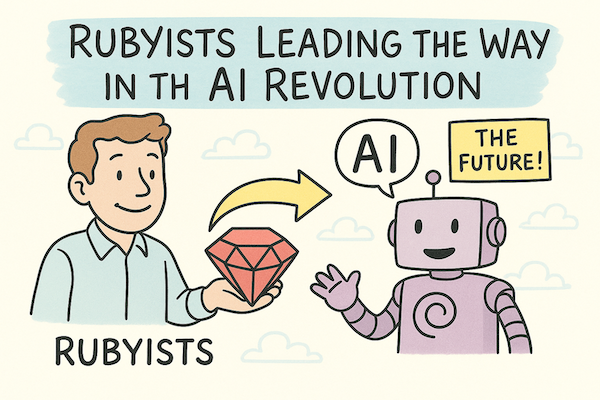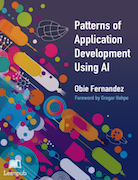
Rubyists Leading the Way in the AI Revolution
Artificial Intelligence (AI) isn’t just knocking on the door of software development—it’s tearing the whole thing down to reimagine how we build, debug, and optimize applications. If you’re like me, you’ve probably wondered: “How will languages like Ruby and frameworks like Rails survive this massive shift?”
Well, good news: they’re not just surviving—they’re leading the way. Intrigued? Let’s break it down.
Why Ruby and Rails Are Perfect for the AI Era
Ruby’s Superpowers (Hint: It’s About YOU)
Ruby isn’t just another programming language; it’s the ultimate productivity booster:
- Expressiveness: Code flows like water, leaving you to focus on solving problems, not wrestling syntax.
- Rails’ Conventions: Convention-over-configuration lets us deliver faster iterations while maintaining sanity.
So, Why Does This Matter for AI?
When you pair Ruby’s dynamism with AI’s advances, you unlock a potential new development paradigm where we move beyond code-as-text to something revolutionary: Prompt-Driven Development (PDD).
What Is Prompt-Driven Development?
Let’s start with this simple idea:
Instead of writing thousands of lines of static code, we write high-level prompts.
Example Workflow:
- You describe functionality in plain language:
“Users enter a name and password. On submit, validate their data and display a dashboard.”
- AI translates it into functionality.
- No boilerplate. No endless debugging.
Key Characteristics of PDD:
- Prompts are dynamic and runtime-driven.
- “Codebases” become living systems that adapt via high-level instructions.
- Say goodbye to static code scaffolding.
Sound wild? It’s actually happening. Here’s a real-world example prompt:
You are an account manager AI. Users request changes.
Ensure actions are valid based on their subscription status.
Notify the account owner of success or failure, then confirm completion by logging the request.
The result? A dynamic Rails application where AI takes care of actual implementation. You define what happens—the AI figures out how.
A Quick Concept Map
Let’s connect some dots. Here’s how AI, prompts, and Ruby fit into this transformative shift:
How Did We Get Here?
Historical Context: Declarative Development & BDD
Prompt-driven development builds on past innovations like:
- HyperTalk (1980s): A pseudo-English language for Apple’s HyperCard.
-
BDD (2000s): Bringing non-technical stakeholders into feature discussions via tools like
RSpecandCucumber.
But older technologies imposed strict syntax rules—AI eliminates that limitation, enabling truly freeform, conversational programming.
Key Difference:
- Then: Structured natural language-like scripts required developer maintenance.
- Now: AI understands context and creates solutions dynamically.
Challenges & Opportunities
Adopting AI-first approaches isn’t without hurdles:
Challenges
- Ensuring deterministic, secure AI behavior.
- Debugging abstracted systems.
- Shifting developers into design-focused roles.
Opportunities
- Efficiency Gains: Shorter cycles; fewer bugs.
- Dynamic UX: Self-adjusting and self-documenting systems.
- Developer Evolution: From writing low-level code to crafting high-level prompts and workflows.
Why Ruby?
Ruby’s flexibility and beauty put it front and center. Imagine writing prompt-driven DSLs in Ruby that feel like…magic.
AI + Ruby and Rails: A Perfect Match
Here’s a bold idea Obie proposes:
What if future Rails apps dynamically translated high-level functionality at runtime?
Imagine AI deeply embedded into Rails, creating “smart” components:
- Auto-inferred method names.
- API auto-connectivity.
- Real-time optimizations.
Future prediction: People will criticize this as “too magical”—just like they dismissed Rails in its early days. And just like before, they’ll be proven wrong.
What Can We Do Today?
Here’s where things get practical:
-
Start with prototypes like
Blueprints.
Tools to help compose prompts and manage AI-driven workflows. -
Use AI inside your Ruby workflows.
Experiment with new abstractions that add AI into Rails apps (see Obie’sRaix Railsframework). -
Join Ruby AI communities.
You don’t have to walk this journey alone! Join forces to influence the ecosystem.
Closing Thoughts
The pace of AI innovation is dizzying, but Rubyists, as always, are perfectly positioned to embrace it. By focusing on expressiveness, developer happiness, and outcomes, Ruby has everything it needs to lead the way in the AI-first development future.
Ready to build this future together?
If you’re a Ruby developer eager to integrate AI into your applications, Obie Fernandez’s Patterns of Application Development Using AI is your go-to guide. This book and also the course offers practical patterns and real-world examples to help you seamlessly incorporate AI components into your projects. It’s a valuable resource for developers looking to enhance their applications with AI-driven features.

Join also the Ruby AI Builders and start pioneering today.